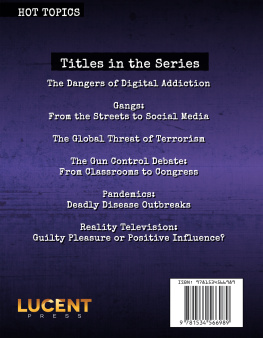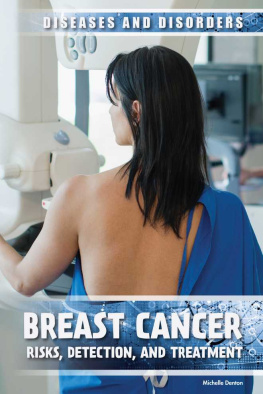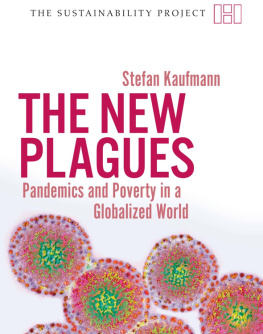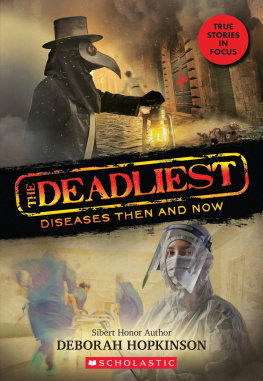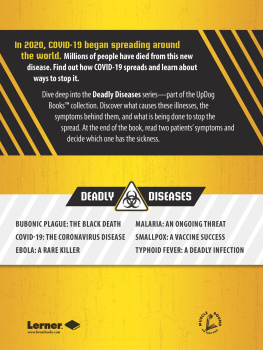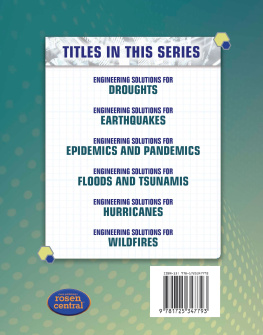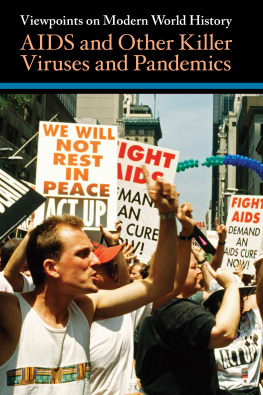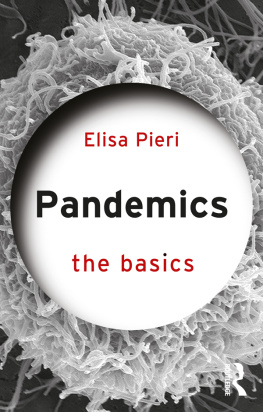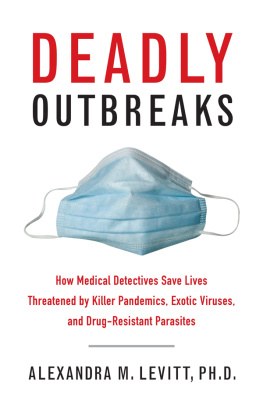
Published in 2020 by
Lucent Press, an Imprint of Greenhaven Publishing, LLC
353 3rd Avenue
Suite 255
New York, NY 10010
Copyright 2020 Greenhaven Press, a part of Gale, Cengage Learning
Gale and Greenhaven Press are registered trademarks used herein under license.
All new materials copyright 2020 Lucent Press, an Imprint of Greenhaven Publishing, LLC.
All rights reserved. No part of this book may be reproduced in any form without permission in writing from the publisher, except by a reviewer.
Designer: Deanna Paternostro
Editor: Jennifer Lombardo
Library of Congress Cataloging-in-Publication Data
Names: Denton, Michelle, author.
Title: Pandemics: deadly disease outbreaks / Michelle Denton.
Description: New York: Lucent Press, [2020] | Series: Hot topics | Includes bibliographical references and index.
Identifiers: LCCN 2018046760 (print) | LCCN 2018048608 (ebook) | ISBN 9781534567603 (eBook) | ISBN 9781534567597 (pbk. book) | ISBN 9781534566989 (library bound book)
Subjects: LCSH: Epidemics--Juvenile literature. | Epidemics--History--Juvenile literature. | Communicable diseases--Epidemiology--Juvenile literature. | Communicable diseases--Prevention--Juvenile literature. | Public health--Juvenile literature.
Classification: LCC RA653.5 (ebook) | LCC RA653.5.D46 2020 (print) | DDC 614.4--dc23
LC record available at https://lccn.loc.gov/2018046760
Printed in the United States of America
CPSIA compliance information: Batch #BS19KL: For further information contact Greenhaven Publishing LLC, New York, New York at 1-844-317-7404.
Please visit our website, www.greenhavenpublishing.com. For a free color catalog of all our high-quality books, call toll free 1-844-317-7404 or fax 1-844-317-7405.
CONTENTS
FOREWORD
A dolescence is a time when many people begin to take notice of the world around them. News channels, blogs, and talk radio shows are constantly promoting one view or another; very few are unbiased. Young people also hear conflicting information from parents, friends, teachers, and acquaintances. Often, they will hear only one side of an issue or be given flawed information. People who are trying to support a particular viewpoint may cite inaccurate facts and statistics on their blogs, and news programs present many conflicting views of important issues in our society. In a world where it seems everyone has a platform to share their thoughts, it can be difficult to find unbiased, accurate information about important issues.
It is not only facts that are important. In blog posts, in comments on online videos, and on talk shows, people will share opinions that are not necessarily true or false but can still have a strong impact. For example, many young people struggle with their body image. Seeing or hearing negative comments about particular body types online can have a huge effect on the way someone views himself or herself and may lead to depression and anxiety. Although it is important not to keep information hidden from young people under the guise of protecting them, it is equally important to offer encouragement on issues that affect their mental health.
The titles in the Hot Topics series provide readers with different viewpoints on important issues in todays society. Many of these issues, such as gang violence and gun control laws, are of immediate concern to young people. This series aims to give readers factual context on these crucial topics in a way that lets them form their own opinions. The facts presented throughout also serve to empower readers to help themselves or support people they know who are struggling with many of the challenges adolescents face today. Although negative viewpoints are not ignored or downplayed, this series allows young people to see that the challenges they face are not insurmountable. As increasing numbers of young adults join political debates, especially regarding gun violence, learning the facts as well as the views of others will help them decide where they standand understand what they are fighting for.
Quotes encompassing all viewpoints are presented and cited so readers can trace them back to their original source, verifying for themselves whether the information comes from a reputable place. Additional books and websites are listed, giving readers a starting point from which to continue their own research. Chapter questions encourage discussion, allowing young people to hear and understand their classmates points of view as they further solidify their own. Full-color photographs and enlightening charts provide a deeper understanding of the topics at hand. All of these features augment the informative text, helping young people understand the world they live in and formulate their own opinions concerning the best way they can improve it.
INTRODUCTION
Microorganisms: Friend and Foe
M icroorganismsa category that includes viruses, bacteria, fungi, and protozoa (single-celled parasites)are the tiniest, simplest life-forms on the planet. They are also the most ancient; the oldest fossil, dating back 3.5 billion years, is of bacteria, and scientists believe they were the earliest forms of life on Earth. Unlike human beings, which are made up of trillions of cells, microorganisms are made up of only one cell or, like viruses, no cells at all.

Stromatolites, such as those shown here, are the fossilized remains of bacteria believed to be the oldest form of life on the planet.
Because the human species evolved in constant contact with microorganisms, some of them benefit people and are necessary for the body to function. Countless kinds of bacteria help humans digest food, make vitamins, and heal themselves. Scientists estimate that each persons body is made up of about 30 trillion cells, but everyone carries about 39 trillion bacteria cells around with them too.
Unfortunately, microorganisms also pose dangerous threats to humanity. Viruses, bacteria, fungi, and parasites can all cause infections in humans, making them very sick and sometimes causing permanent damage to the body or even death.
When microorganisms get inside the human body, the encounter often leads to infection, especially if the body is unfamiliar with that particular type of microbe. The bodys immune system responds and, in most cases, wins the battle, killing off the invading germs with fever, chemicals, or attack cells called antibodies. In fact, illness among humans tends to be the exception rather than the rule, even though there are literally hundreds of thousands of species of potentially dangerous microbes living everywherein the soil, in water, and in virtually every type of creature that lives. Often, the body can even produce lifelong immunity against particular germs. Sometimes, too, the human defenses are good but not perfect, and a type of standoff occurs in which certain symptoms become chronic, or long-term, but are not deadly. In other cases, however, the end result may be death for both the human host and the microbe.
Throughout this process of infection, rapidly multiplying germs may reach new human hosts through sneezing, coughing, bleeding, diarrhea, or other means of transmission. Microorganisms strongest weapon is their ability to replicate and modify themselves quickly, evolving in many different directions in a fight to survive. The microorganismssometimes called microbeschange their genes, or mutate, each time they reproduce, enabling them to adapt to new environments and jump between animals, plants, and humans.
Next page
